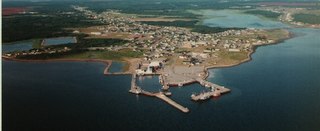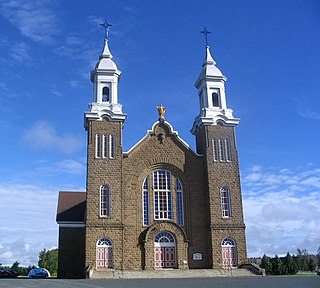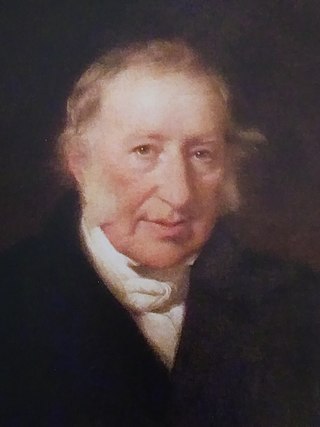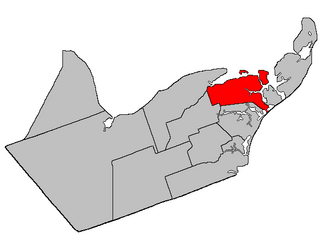
Bathurst is a city in northern New Brunswick with a population of 12,157 and the 4th largest metropolitan area in New Brunswick as defined by Census Canada with a population of 31,387 as of 2021. The City of Bathurst overlooks Nepisiguit Bay, part of Chaleur Bay and is at the estuary of the Nepisiguit River.

Westmorland County is a county in New Brunswick, a province of Canada. It is in the south-eastern part of the province. It contains the fast-growing commercial centre of Moncton and its northern and eastern suburbs. Also located in the county are the university town of Sackville and the local tourist destination of Shediac.

Shediac is a heavily Acadian town in Westmorland County, New Brunswick. The town is home to the famous Parlee Beach and is known as the "Lobster Capital of the World". It hosts an annual festival every July which promotes its ties to lobster fishing. At the western entrance to the town is a 90-ton sculpture called The World's Largest Lobster. It is believed that chiac, a well-known Acadian French patois, was named after Shediac.

The Université de Moncton is a Canadian francophone university in New Brunswick. It includes campuses in Edmundston, Moncton, and Shippagan.

Memramcook, sometimes also spelled Memramcouke or Memramkouke, is a village in Westmorland County, New Brunswick, Canada. Located in south-eastern New Brunswick, the community is predominantly people of Acadian descent who speak the Chiac derivative of the French language. An agricultural village, it has a strong local patrimony, key to the history of the region. It was home to Mi'kmaqs for many years and was the arrival site of Acadians in 1700. A large part of these Acadians were deported in 1755, but the village itself survived.

Tracadie-Sheila is a former town in Gloucester County, New Brunswick, Canada. It is now part of the Regional Municipality of Tracadie.
Hédard Joseph Robichaud was an Acadian-Canadian Member of Parliament, Cabinet member, Senator and the first Acadian to be Lieutenant Governor of New Brunswick.

Lamèque is a former town in Gloucester County, New Brunswick, Canada. It held town status prior to 2023 and is now part of the town of Île-de-Lamèque.

Le Goulet is a former village in Gloucester County, New Brunswick, Canada. Located several kilometres east-southeast of downtown Shippagan, it sits on the Gulf of St. Lawrence. Formerly an incorporated village, it is now part of the town of Shippagan.
Neguac is a Canadian village in Northumberland County, New Brunswick.

Paquetville is a former village in Gloucester County, New Brunswick, Canada. It held village status prior to 2023 and is now part of the town of Hautes-Terres. It is on the Acadian Peninsula at the intersection of Route 340, Route 135 and Route 350.

Miscou Island is a Canadian island in the Gulf of St. Lawrence at the northeastern tip of Gloucester County, New Brunswick.

Charles Robin was a merchant from the Isle of Jersey who traded between the maritime region of Canada and the British Isles.

Lamèque Island, , is a Canadian island in the Gulf of St. Lawrence at the northeastern tip of Gloucester County, New Brunswick.

Inkerman is a geographic parish in Gloucester County, New Brunswick, Canada.

Caraquet is a geographic parish in Gloucester County, New Brunswick, Canada.

Shippegan is a geographic parish in Gloucester County, New Brunswick, Canada. Located in the northeastern corner of the province at the end of the Acadian Peninsula, the parish consists of the three main islands of Taylor, Lamèque, and Miscou, along with several smaller islands and tidal wetlands; Taylor Island is now joined to the mainland by an isthmus, which is crossed by a causeway.

Allardville is a geographic parish in Gloucester County, New Brunswick, Canada,

Caraquet is a town in Gloucester County, New Brunswick, Canada.

Black Canadians in New Brunswick refers to Black Canadians from the province of New Brunswick, notably of those whose ancestors, much like those of Black Nova Scotians, originated from the Colonial United States as slaves or freemen and arrived in New Brunswick during the 18th and early 19th centuries. As of the 2021 Canadian census, 12,155 Black people live in New Brunswick, making them the largest visible minority group in the province. The first recorded Black person in present-day New Brunswick was a Black man from New England who was forcibly taken during a French raid in the late 17th century.



















